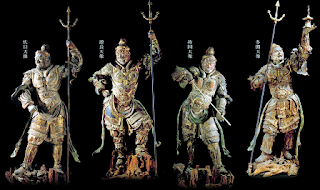Shitenno-ji Temple in Osaka
There is a historical temple in Osaka, which is Shitenno-ji Temple. The beginning of Shitenno-ji Temple, 592, is older than the one of Horyu-ji Temple, which is the oldest existing wooden-built temple in the world. The founder of Shitenno-ji Temple is Shotoku-Taishi, who built Horyu-ji Temple as well.
Unfortunately, Shitenno-ji Temple was devastated in an air-raid of the American army during World War II, and the current temple was rebuilt after the war. So then the value of the buildings of the temple is less than Horyu-ji Temple, nonetheless, the value of the legacy of the temple compares favorably with Horyu-ji Temple, which is one of the world cultural heritage sites.
The super characteristic positioning of Shitenno-ji Temple
One of the characteristics of Japanese beauty is asymmetry. However, the positioning of this temple is synonymous. Many cathedrals of Buddhism in Japan are constructed with four important buildings, “chumon”:a central gate, “goju-no-to”: a five tiered pagoda, “kondo”: a building for prayer and “ko-do”: a building where priests study. Each building faces to the south, it was the custom at that time. The theme of the construction was how to position them. The four buildings in Shitenno-ji Temple is synonymously placed on the straight north-south line.
That is very particular, in addition, in entering the central gate you soon come across the five tiered pagoda. And if you want to go to the kondo you have to walk around the five tiered pagoda, intentionally, it is inconvenient. As I have written, a synonymous placement of buildings is particular, but why was the temple built inconveniently in a straight line?
The legacy of Shotoku-Taishi
The name of Shitenno-ji Temple originates from “shitenno”, who are four guarding-gods of Buddhism. The founder of this temple, Shotoku-Taishi, strongly believed in Buddhism. Before the coming of Buddhism to Japan ancient Japanese people only believed in Shintoism. However Buddhism officially came to Japan from the Asian continent in 538, so believers of Buddhism increased since then. On the contrary there were opponents of Buddhism. During a historically significant battle between supporters of Buddhism and supporters of Shintoism in 587, Shotoku-Taishi aged 13 prayed to shitenno for the victory of the supporters of Buddhism and pledged to build Shitenno-hi Temple for the shitenno when all done.
The meaning of the legacy
Now, I will write about the legacy of this temple, and it is the same as the legacy of the intention of Shotoku-Taishi. A keyword of the legacy is “west”, which contains two view points, one is from Buddhism and the other is from a diplomat of Japan.
The aspect of Osaka until the thirteen century was different from the current aspect of Osaka. To the west-side of the temple was the sea and there was no land and no forest blocking the westward view from the temple. The temple was a good place to see the sun sinking into the sea.
Look at the picture above. This is a picture which was taken from the western gate of Shitenno-ji Temple to the due west, where people prayed to a sunset of the autumn equinox. In addition, at the vernal equinox as well as the autumn equinox people pray to the sunset at the same place. In Buddhism the far west means heaven. And it is said in Buddhism that praying to the sunset in the west is good practice in order to be reborn in heaven. Ultimately, Shitenno-ji Temple faces to the west in favor of introducing people to heaven, in spite that the four important buildings face to the south.
In 581 in China “Zui” unified the country. It meant the strong power of the country by which many countries including Japan nearby China were subconsciously threatened. Shotoku-Taishi, who had governed Japan from 592, had pondered his political strategy toward Zui. Shotoku-Taishi didn’t accept being dependent on China and wanted to make a good relationship with China as an independent country. Buddhism was standard and famous in China at that time, so then showing that Japan was kind to Buddhism was important as a diplomat policy. In short, Shitenno-ji Temple was an exhibition for the sake that Japan was a country of Buddhism. Of course China is located in the west of Japan. As a result, the facial aspect of the temple which shippers from China saw from a ship was the asymmetrical form of the four buildings. Yes, Shotoku-Taishi might have wanted to exhibit the asymmetrical form of the temple to Chinese diplomatic guests.









Comments
Post a Comment